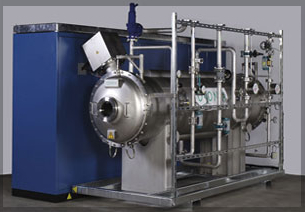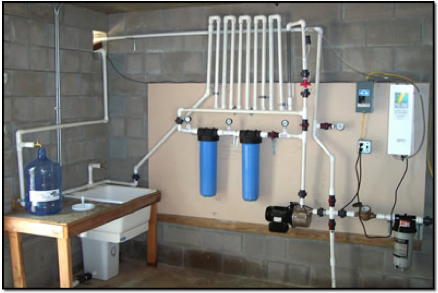Ozonation


Photo: Living Waters for the World.
Ozone is a powerful oxidant and has many uses in water treatment, including oxidation of organic chemicals. Ozone can be used as a primary disinfectant. Ozone gas (O3) is formed by passing dry air or oxygen through a high-voltage electric field. The resultant ozone-enriched air is dosed directly into the water by means of porous diffusers at the base of baffled contactor tanks. The contactor tanks, typically about 5 m deep, provide 10–20 minutes of contact time. Dissolution of at least 80% of the applied ozone should be possible, with the remainder contained in the off-gas, which is passed through an ozone destructor and vented to the atmosphere.
The performance of ozonation relies on achieving the desired concentration after a given contact period. For oxidation of organic chemicals, such as some oxidizable pesticides, a residual of about 0.5 mg/l after a contact time of up to 20 minutes is typically used. The doses required to achieve this vary with the type of water but are typically in the range 2–5 mg/l. Higher doses are needed for untreated waters, because of the ozone demand of the natural background organics.
Ozone reacts with natural organics to increase their biodegradability, measured as assimilable organic carbon. To avoid undesirable bacterial growth in distribution, ozonation is normally used with subsequent treatment, such as biological filtration or granular activated carbon (GAC), to remove biodegradable organics, followed by a chlorine residual, as ozone does not provide a disinfectant residual. Ozone is effective for the degradation of a wide range of pesticides and other organic chemicals.
Suitable conditions
Ozone is currently the next most widely used drinking water disinfectant after chlorine (there are some 1100 water treatment plants using ozone worldwide), although its use is almost exclusively limited to the industrial countries with high-integrity piped water networks. Ozonation has become popular in North America partly because of its superiority over chlorination. It enhances the coagulation process despite its inherent weakness in leaving practically no residual in the distribution system.
However, ozone does not provide residual protection against recontamination in the distribution system. Therefore, its common use is to pre-treat the water source before chlorination in a municipal system, so that a smaller chlorine dose is required.
Although ozonation can effectively disinfect water, it is not suited for most developing country applications owing to its high cost, need for operational and maintenance infrastructure, and lack of residual protection in the distribution system.
Construction, operations and maintenance
Care is needed in operating and maintaining the generators, and in destroying excess ozone so it is not released into ambient air.
Acknowledgements
- Guidelines for Drinking-water Quality. Fourth edition. WHO, 2011.
- Gadgil, Ashok. DRINKING WATER IN DEVELOPING COUNTRIES. 1998.
